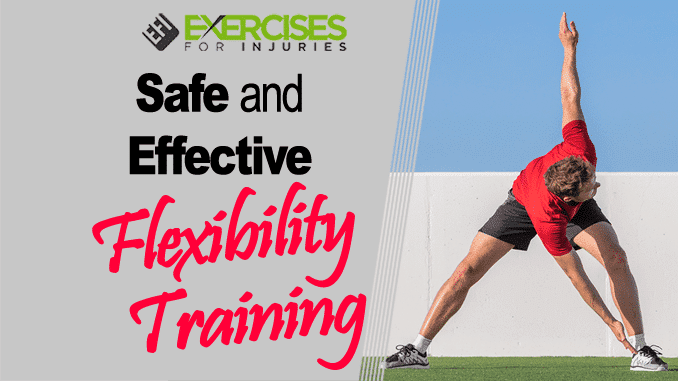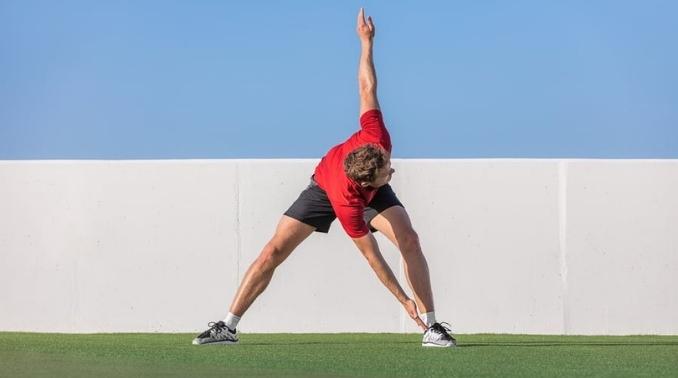
How to Improve Range of Motion without Causing Injury
An often neglected element of a well-rounded fitness regimen, flexibility training is the key to improving range of motion in the joints, reducing soreness in muscles and creating long, lean muscle tissue throughout the body. Long periods of sitting, exercising at high-intensity levels and even the way you sleep can cause muscles to become tight and imbalanced. These imbalances cause chronic pain most often felt in the back. Improving your flexibility can help relieve pain, aid in injury prevention and help you reach your overall fitness goals.

It’s important to remember that, as with all forms of fitness, flexibility cannot be achieved in one workout. Using safe and effective flexibility training techniques will ensure that you get results without sidelining your fitness goals.
Warm Up
No matter what kind of workout you’re planning for the day, a quality warm-up should always precede. Warming up the body accomplishes two main goals — aiding in injury prevention and increased productivity of your workout.
Muscles do not perform well when they are stiff and cold. This is especially true when working toward increased flexibility as stretching cold muscles is likely to result in strains. Injuries like muscle strains not only cause pain but also prevent you from maintaining your workout routine since rest of the affected area is necessary for healing.
In addition to helping prevent injury, you’ll gain a much greater benefit from your workout if you allow for a proper warm up first. The slower increase in body temperature, blood flow and respiration rate from a warm-up prepares the body for more efficient calorie burn. Because your body has already begun to use the most readily available energy sources during your warm up. By the time you reach the higher intensity levels of exercise. It is already working to break down fat stores to maintain the exercise intensity level. Essentially, by warming up, you are communicating with your body, “I’m about to need some energy broken down.” This results in a much more efficient and effective workout.
A quality warm-up should increase your heart rate and respiration rate slowly. In addition, you’ll want to work toward loosening the joints and muscles that will be targeted during the more strenuous parts of your workout. Dynamic stretching coupled with more basic exercises like walking and squats should begin a good warm up. You should feel stiffness leaving the muscles as they stretch and move gently.
Remember to focus your warm-up specifically on muscle groups that you intend to work the hardest. For example, if you will be working the core intensely in your workout. Be sure to loosen and warm up the spine, abdomen and back muscles thoroughly. The whole body should feel warm at the end of a good warm up. But targeting your workout zone will give you the most benefit to prevent injury and achieve the most gain.
Dynamic Stretch vs. Static Stretch
When looking to improve flexibility and range of motion, you’ll want to know when and how to use dynamic stretching versus static stretching.
a. Dynamic Stretching
A dynamic stretch involves movement of the muscles and joints. The goal of dynamic stretching is to loosen stiff joints and increase blood flow to muscles resulting in warmer, more elastic muscle fibers, tendons, and ligaments. Dynamic stretches are perfect for warming up prior to more strenuous exercise. Some examples of dynamic stretches include moves like a toe reach to overhead reach, knee raises, lunges and twists. These types of moves should not only be used before high-intensity exercise but are also necessary before performing static stretches.
b. Static Stretching
Static stretching involves holding a stretch steadily at the deepest point the stretch can be reached. The goal of a static stretch is to deepen the reach achievable in a particular position and to release tension in the muscles being stretched. Static stretching should be used when the body is already warm either from a proper warm-up or a completed workout. Attempting to perform deep stretches on cold muscles is likely to cause injury. A combination of dynamic and static stretching is the best approach toward achieving overall better flexibility safely.
Tips for Daily Flexibility Improvement
A few small additions to your daily routine can make a big difference in your flexibility. With better flexibility comes improved posture, reduced muscle pain and stress relief. Try implementing these simple techniques into everyday life to see big changes in the way your body feels.
1. Start Your Day
For an energizing and uplifting start to your day, try making your way through a short dynamic stretching routine. Yoga or any basic, feel-good movements that warm up joints and muscles are perfect for getting the blood flowing and improving flexibility. Try working through a few sun salutations to get a full body stretch while simultaneously increasing heart and respiration rates. This oxygenates blood flow and allows your sleepy body to perk up and stay loose throughout the day.
2. At Your Desk
Desk jobs are notorious for causing aching backs, stiff necks and all the general health concerns associated with a being sedentary. To break this cycle, try adding a short and simple flexibility routine right at your desk. Focusing on motions like forward neck rolls, shoulder rolls and torso twists loosens up muscle groups that often get tight while seated at a computer desk. When possible, take advantage of a few minutes to stand up, move around some and stretch your joints. For this tip, try to do what feels good. The main goal is to get through the workday a little less stiff and a little more relaxed.
3. End Your Workout
While warming your muscles up is vitally important to performing any fitness training safely, a cool-down stretch is the best way to improve flexibility daily. Especially after high-intensity exercise, spending a few extra minutes to cool down and stretch your muscles properly can result in profound improvement of muscle tightness and soreness as well as improving overall flexibility. Your cool down is where you want to implement static stretches that focus on deepening the reach of your muscles and joints. Be sure to focus on taking deep breaths throughout your static stretches to keep oxygenated blood flowing to the whole body.
4. End Your Day
Ending your day with some flexibility training is a great way ensure you get better sleep and wake up feeling less stiff and more energetic. Before bed, try making your way through a 10-15 minute routine that starts with dynamic stretching and ends with static stretches. With your dynamic moves, focus on loosening tight muscles from the day and warming up muscles you want to stretch more deeply in the minutes that follow. Once you feel warm and loose, stretch your major muscle groups like quads, hamstrings, abdomen, and the muscles of the upper back. Pay special attention to any sore areas.
5. Areas of Focus
Targeting specific parts of the body when flexibility training can result in the most impactful benefits. Most of us carry our stress in the form of tight muscles in the core, hips, and neck regions. Focusing on loosening these areas can make a huge difference in how you feel daily. To work on the hips, try moves like lunges and squats as well as stretches like pigeon pose and butterfly. Twists and cat-cows are great for lengthening and strengthening the muscles of the core while neck rolls, shoulder rolls, and rhomboid stretches are ideal for relieving tightness in the neck and upper back.
Conclusion
Taking steps to improve flexibility can have a lasting positive impact on many facets of life. From stress relief to improved posture and fitness, flexibility is just as productive and important as cardio or strength training. Safe flexibility training can be achieved through a few simple methodologies and small additions to your daily routine. Always remember to warm up before deeply stretching muscles. Using dynamic stretches in conjunction with static stretches is the best way to improve flexibility naturally and safely. Try implementing small doses of stretching into your everyday life to see the most benefit.
If you want to speed up recovery, reach your fitness goals faster and rapidly hit your peak, then check out the Recovery Workouts program, here!



